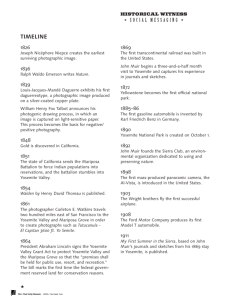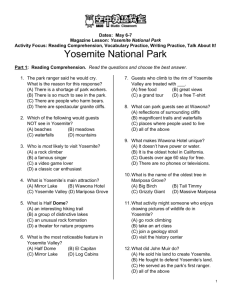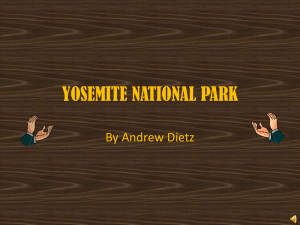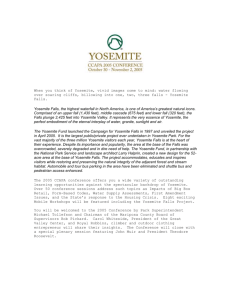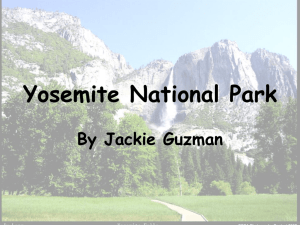Yosemite National Park
advertisement
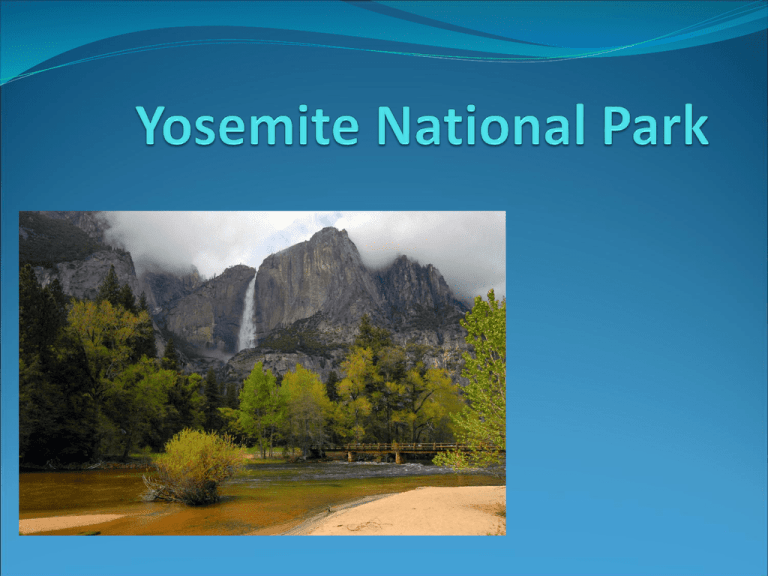
Location California, United States of America Weather/Climate Receives most precipitation from January – March Summers are warm and dry, while Winter is the season of snow and solitude Spring and Fall are transitional months with warm sunny days that can turn into storms Clouds can build during summers to produce incredible thunderstorms Landforms Rock formations, meadows, wetlands, waterfalls, giant sequoias, mountains, and the wilderness (forests) Glacier Point, Mariposa Grove, Half Dome, Yosemite Valley, Cook’s Meadow, Sentinel Meadow, Stoneman Meadow, and Leidig Meadow, and many more Waterways There are a vase amount of waterfalls, rivers, lakes, and creeks in Yosemite. Horsetail Falls, Yosemite Falls, Tenaya Lake, Mirror Lake, Hetch Hetchy Reservoir, and more The rivers flow through Wawona, Yosemite Valley, Tuolumne Meadow and into creeks. Vegetation Located all over park, but mainly in Foot-Hill Woodland Zone, Alpine Zone, and the forests Lichens, black oak, wildflower, sequoias, and invasive plants Over 200 types of non-native plants Walks and trails were made in the park just to show the variety of plants and how beautiful they are Animals High diversity in species (over 400) Amphibians, reptiles, fish, birds, mammals, insects and their relatives There are about 120 species of amphibians, 22 reptiles, and 256 birds. Fish are both native and non-native Red fox, black bear, bobcat, spotted owl, bats, goldenmantled ground squirrel, bass, and many more Environmental Issues The air quality is bad because of pollution and smoke from natural fires in the park Aquatic resources are decreasing Invasive species are threatening biodiversity of vegetation Douglas-fir Tussock Moth is eating away white fir trees Soundscape in park is getting too loud so at times it is hard to hear the beauty of the nature Dam removal Forest pests History/Culture 7 present day tribes descend from people who first called Yosemite their home Europeans arrived in mid-1800’s and caused disruption which displaced native population Early white settlers had writers, artists, and photographers who spread fame of “the Incomparable Valley” Euro-Americans settled on foot, horseback, and rail President Abraham Lincoln signed a bill granting Yosemite Valley and Mariposa Grove to California in 1864 John Muir helped create idea of Yosemite National Park in 1890 People used to mine and lived in lodging establishments (Wawona Hotel) Museums at park have more than 4 million items from early settlers The library at the park has 10,000 books related to the park, as well as articles and photographs Preservation Efforts Done through archeological and architectural recognition Structures, artifacts, and trails symbolize human value Archeologists documented over 1,500 sites from first settlers and kept everything they left behind to uncover clues of settlement, cultural history, demography, economic systems, and social organizations Natural settings of Yosemite influence architecture of buildings in the park Old El Portal Schoolhouse

